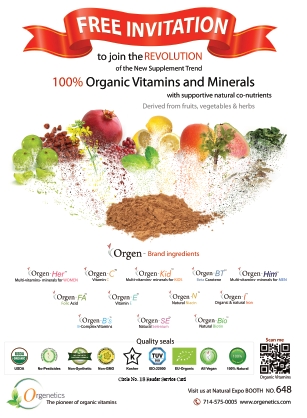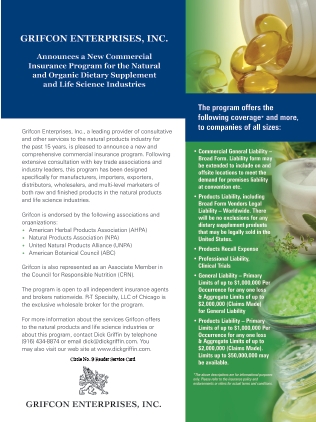In the natural food flavors and colors market, staying current and diversifying is the name of the game. Only the strongest, most palatable natural flavors and the brightest, most appealing colors survive, and jumping on the right bandwagon can be just as important as forging bold, new paths.
Fortune favors the bold in flavors, colors and sweeteners alike, and here we’ll hear from industry insiders about which innovations will wind up in our foods and beverages in the near future. We’ll also learn about some issues facing the contemporary food ingredient scene along the way.
Color My World
In terms of consumer acceptance, color is foundational. “Colors have far more influence with regard to consumer acceptance of foods than we would normally think,” says Robert McQuate, Ph.D., CEO and co-founder of GRAS Associates, Bend, OR. Establishing a new natural color additive does not require U.S. Food and Drug Administration (FDA) certification, as new synthetic colors do. The FDA requirements for safety must be met, however. Color additives actually become approved and get listed in the Code of Federal Regulations, where FDA maintains a relatively short, official list. It just isn’t very often that a substantially new color emerges from the world of natural resources.
Take the color blue, for example. There’s plenty of it up in the sky, but here on terra firma, natural color suppliers have struggled to create a stable natural blue coloring. The colors that have been developed in challenging categories like blue and green are often too acidic and unstable. “A blue color derived from natural sources had recently only been available in the United States for food applications in the range of pH 5.5–7.0,” says Jessica R. Jones-Dille, senior manager of industry trends and market research for WILD Flavors, Inc., Erlanger, KY.
The company is excited about an acid-stable blue they’ve developed, which they say will be targeted for both food and beverage products. Naturally derived from fruit, this innovation fills a gap in the standard offerings for both food and beverage color. A stable blue will, ideally, not only deliver various shades of blue, but also provide the foundation for other colors, such as green, purple and black.
This type of innovation will be typical, as the market share of natural colors versus synthetics is growing, according to market research firm RTS Resource. Out of the total colors market of $1.7 billion, natural colors comprise $650 million, and this share grew 6.5% last year, higher than the total colors growth of 4% (1). The firm also forecasts that within  five years, half of all colors used in confections will be natural. The majority of meat and savory products already use natural coloring (1).
five years, half of all colors used in confections will be natural. The majority of meat and savory products already use natural coloring (1).
One trend sure to endure in the natural color segment is that of colors which also serve as functional ingredients. Consumers are relentless in their pursuit of dietary choices that do everything for them, and a natural color additive that imparts health is sure to succeed. Suppliers know this, so there is a movement toward “dark” natural colors, the idea being that these hues indicate the natural presence of nutritious elements, like antioxidants, in a given food. The hope is that consumers are savvy of this, and will gravitate toward foods naturally fortified with nutritious coloring extracts just because of the way they make a product appear.
Lycopene is an example of a natural color on the rise, as are other carotenoid pigments that provide shades of yellow and red. The challenge is stability, as natural colors traditionally do not handle rough treatment or high temperatures as well as synthetic colors can. But where the shoe fits, suppliers are opting for natural colors over synthetic to meet consumer demand. For example, adding Yellow No. 5 to a product with fruit filling in order to enliven its color may be an option of the past. Turmeric oleoresin, a natural colorant, has been found to work well in such situations.
Behind the Taste
Framing taste. Keeping flavor profiles in line with consumer taste buds while maintaining the health of natural products proves a challenge for natural flavor suppliers. Healthy, low-calorie beverages especially pose a quandary. “A major issue is the delivery of ‘true to nature’ flavor profiles in challenging beverage bases,” claims Domenick Luccarelli, director of business development for A.M. Todd, Kalamazoo, MI.
Flavors that present development difficulties, he says, are fresh citrus, berry and other red and tropical fruit flavors, especially when they must be applied to low-/zero-calorie, nutrient- fortified beverages. These products also like to maintain a clean label, with few extraneous ingredients that might put off consumers. So achieving the result of a stable, expected taste profile while maintaining a product’s healthful qualities presents a definite hurdle. Differentiating flavor sub-variants from one another, for the purpose of consumer recognition, is a prevalent development issue as well, according to Luccarelli. “The consumer is not looking for just orange, but for specific types of orange such as blood orange,” he says.
also like to maintain a clean label, with few extraneous ingredients that might put off consumers. So achieving the result of a stable, expected taste profile while maintaining a product’s healthful qualities presents a definite hurdle. Differentiating flavor sub-variants from one another, for the purpose of consumer recognition, is a prevalent development issue as well, according to Luccarelli. “The consumer is not looking for just orange, but for specific types of orange such as blood orange,” he says.
“The market has fragmented, and product differentiation seems to be the key to product survival and business longevity,” says A.M. Todd’s director of product development Jim Cain. With new ingredients going to market all the time,and novel issues attending their use in food products, flavor suppliers must keep on their toes to keep up with the new challenges being presented.
Specifically, new ingredients may have negative flavor attributes that must be addressed, via masking or some other form of taste profile modification, if they are ever to be accepted by consumers. “We offer a variety of taste modification technologies that help overcome vitamin or other functional ingredient off-tastes or other off-tastes that arise from product processing,” says Jones-Dille. It isn’t all about offsetting the negative though. Suppliers also strive to accentuate the positive and create a little harmony. Jones-Dille’s company is developing and testing a range of flavors designed to work in concert with healthy ingredients, such as green tea or superfruit extract. “These flavors complement the natural tastes of the product and at the same time, they counter-balance any undesirable notes for wider consumer appeal,” she says.
 Some areas in which suppliers are innovating now include organic flavors, bitterness masking ingredients (allowing for optimal flavor impact in certain sweetener systems) and the stability/durability of flavor systems, from original processing through supply chain distribution. A mantra among flavor suppliers is that it only matters how a product tastes to the consumer, not at the facility, and not on the shelf.
Some areas in which suppliers are innovating now include organic flavors, bitterness masking ingredients (allowing for optimal flavor impact in certain sweetener systems) and the stability/durability of flavor systems, from original processing through supply chain distribution. A mantra among flavor suppliers is that it only matters how a product tastes to the consumer, not at the facility, and not on the shelf.
In framing taste, it largely becomes a task of aligning with the manufacturer’s purposes. In the words of Greg Mondro, senior flavor chemist, Cargill Flavor Systems, Minneapolis, MN, rather than creating a particular flavor, the challenge is creating “a flavor that delivers not just great taste and aroma, but also masks challenging attributes in the customer’s formulation— mouthfeel, bitter masking, sweetener modifications.”
Trending flavors. Like the nutritious fruit bodies themselves, superfruit extracts are still hot commodities in both natural colors and flavors. “Pomegranate and acai are now mainstream. Many of the emerging flavors, such as maqui and baobab, are more difficult to deliver and to formulate since there is not a taste standard in the consumer’s mind,” says Eric Robbins, senior flavorist with A.M. Todd. The public also wants to see these desired ingredients standing all alone on the ingredient label. “Consumers want to see Acai, and not ‘Acai with other natural flavors’,” says Luccarelli.
Robbins also cites the emergence of tea in unexpected places, beyond the beverage sector, as a trend providing a challenge to flavorists. “The primary reason (for its popularity) seems to be due to its ‘health halo’ or its ‘good for you’ image. Tea can be a difficult ingredient to flavor,” he says.
|
Stevia on Top These special ingredients are aids that enhance the sugar-like qualities of a product, increasing the flavor profile’s immediate sweetness while decreasing bitterness. Suppliers have been innovating to offer more options like these to manufacturers, who are looking to cut costs in the face of high sugar prices. “Trade media has given a lot of coverage on the strong growth in stevia product usage,” says Robbins, who adds that his company is seeing more “fractions of Stevia rebaudiana” labels on products. The highly purified Reb A steviol glycoside, the compound in stevia leaves responsible for their sweetness, was the first major product to gain market share, and is currently the most abundantly utilized on the market, according to Robbins. However, other newly FDA approved forms are poised to see use, such as proprietary blends of Reb A, Reb C, Reb D and Reb F. Many of these are products will be marketed as stand-alone sweeteners, while others will see implementation as sweetness “enhancers,” working in conjunction with other common sweeteners. Stevia can’t always fill sugar’s boots alone, at least not so far. That’s why suppliers have been putting other innovations to use in conjunction with alternate sweeteners like stevia. “Going from an all-natural, full-calorie product to a reduced-calorie version requires more than replacing sugar with a natural high potency sweetener,” says Mondro. There are basic differences in sweetness profile, mouth texture and on the delivery of flavor when replacing sugar. “In addition, if fortifying or functional ingredients are present, reducing or removing sugar could highlight the taste challenges even more. Sugar is a great masker/modifier, so when you remove it, you lose those attributes,” says Mondro. Overcoming these challenge means recreating the desired flavor and sugar-like texture of a full-calorie product. |
Global tastes are infiltrating the curious North American market. “Ethnic flavors continue to be trendy in foods—especially those inspired by Asian and African cuisines,” says Jones- Dille. When it comes to natural fruit flavor profiles, suppliers should be bold and go for the gusto, with classic and “new” fruits alike. In addition, Jones-Dille says, “calling out the fruit’s provenance and presenting specific fruit types, such as Meyer Lemon and Fuji Apple, has grown in popularity.”
“We are seeing a lot of requests for all kinds of Umami flavors, or more widely, flavor enhancers,” says Simon Poppelsdorf, vice president of flavor research and development for Bell Flavors & Fragrances, Northbrook, IL. Umami is a term influenced by Eastern cuisine and referring to the category of savory tastes, including that of meat or cheese. Flavor enhancers generally, Poppelsdorf says, are not geared toward imparting a specific flavor to a processed food, but toward enhancing the overall flavor profile of the food in question.
“We are seeing a lot of interest in any flavor that can help to reduce salt in processed food,” Poppelsdorf says, adding, “Here again, Umami can help to offset the lack of flavor when salt is reduced and potassium chloride cannot be used.” Sodium reduction is a major push, as consumers continue to receive recommendations from all quarters to reduce sodium intake for their health.
Indeed, the increasingly negative connotations associated with salt and its use as a preservative are pushing the spice to the side, and the situation has suppliers ready to fill in the gap. “Currently, millions of dollars are focused on delivering improved salt substitutes that could follow the sugar substitute business model,” Cain says. However, he cautions that this may prove a more challenging feat than anticipated. “Since the salt taste mechanism is substantially more complex than sugar, the current results have been limited,” he says.
Financing flavors. “It is important to find the ‘gold standard’ and understand the key notes that drive flavor acceptance before initiating development work. Our biggest challenge is a ‘secure supply chain’ for key natural raw materials at a viable cost,” says Luccarelli. Balancing costs and taste is the central concern for flavor suppliers. It is a constantly changing dynamic, because as product formulations and commodity costs change, suppliers must adapt quickly.
It is a matter of identifying a potential solution to a flavoring problem, assessing market/consumer demand, and evaluating what makes sense from a business standpoint. “Synchronizing these events is a crucial step and every development project has its own unique challenges. Many projects will never make it to fruition,” says Cain. Luccarelli says that natural flavor suppliers like his company strive to investigate and mimic “nature” as closely as possible, both in source material and final flavor profile, while keeping in mind the important balance between cost and consumer acceptance.
Once a prospective flavor program is identified, “knowing the regulatory environment and matching it to your company’s acceptable risk profile is critical to success,” says Cain. Taking organic ingredients as an example, he says that suppliers must actively look for new ingredients and sources. Materials must always be properly documented to ensure the safety and viability of the final product. Analyzing dynamic factors like time of year and current ingredient availability is crucial to avoiding problems down the road.
Labeling health. The ideal of a “clean label” creates a demand that natural ingredient suppliers constantly labor under. In a market where current consumer expectations are that “natural means healthier,” consumers are demanding “simple/clean” ingredient statements as a sign of a safe product. Safety and stability are best represented via package and process, and not only through ingredients, experts say.
However, the goal of stability sometimes comes into conflict with the final taste profile. “Natural preservatives, e.g. rosemary extract, present taste challenges that may be in conflict with the end product’s overall flavor,” says Luccarelli. Scenarios like these require clever taste masking on the part of flavorists.
Suppliers recognize the fact that obesity, diabetes and other diet-related illnesses and conditions are increasing at epidemic rates. Some feel that if diet is the culprit, they can help turn the tables and make it part of the solution. This attitude can come through in product marketing efforts. “As we have transitioned from ‘the absence of negatives’ to ‘the presence of positives’ consumer messages, we have developed more compelling products,” says Cain.
Natural food additives will always face limitations that their synthetic counterparts do not. “The industry is certainly facing a lot of constraints looking for natural sources of raw materials. The reason for this, certainly for the flavor and fragrance industry, is the tonnage of product used compared to other crops is always small and most of the time not very profitable for the farmer,” says Poppelsdorf.
Yet the segment is growing and statistics show it continues to gain ground. “There’s a greater degree of comfort with ingredients that are extracted from natural sources,” McQuate says. Consumers want to know they are consuming natural ingredients, and suppliers remain willing to oblige. WF
Reference
1. N. Gray, “Natural Colours On The Rise, But Synthetics Not Dead Yet,” foodnavigator-usa.com, Nov. 23, 2010, www.foodnavigator-usa.com/Financial-Industry/Natural-colours-on-the-rise-but-synthetics-not-dead-yet, accessed Nov. 30, 2010.
Published in WholeFoods Magazine, January 2011









